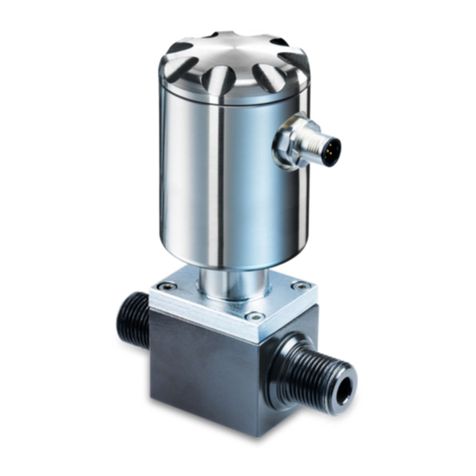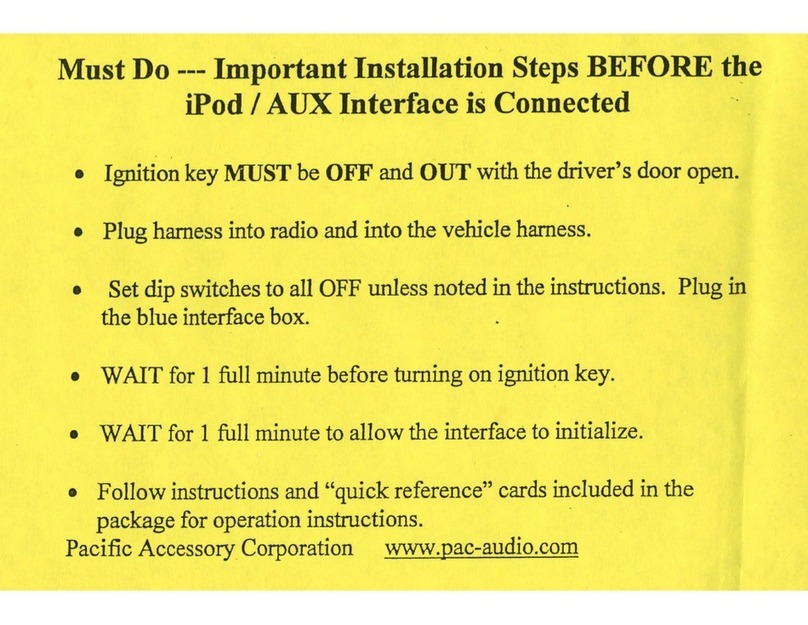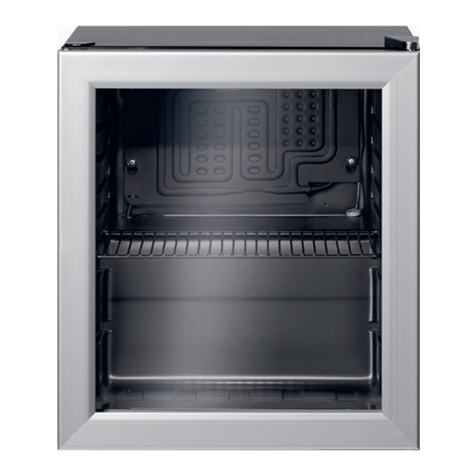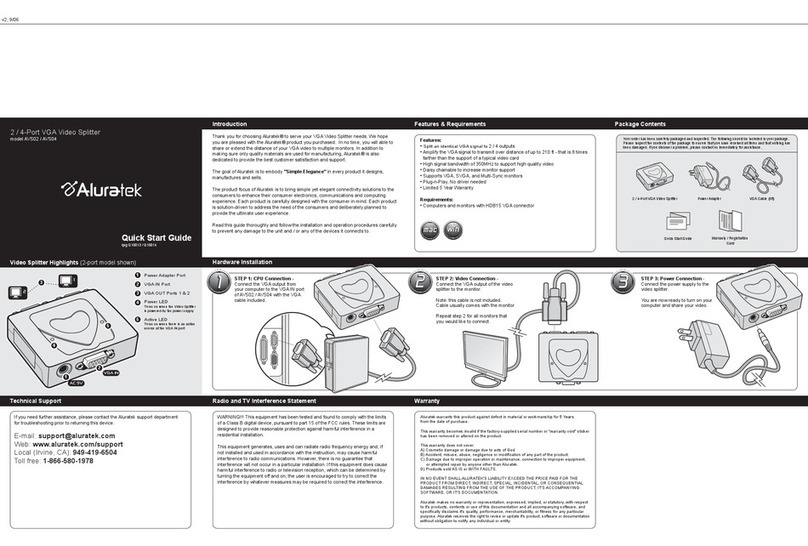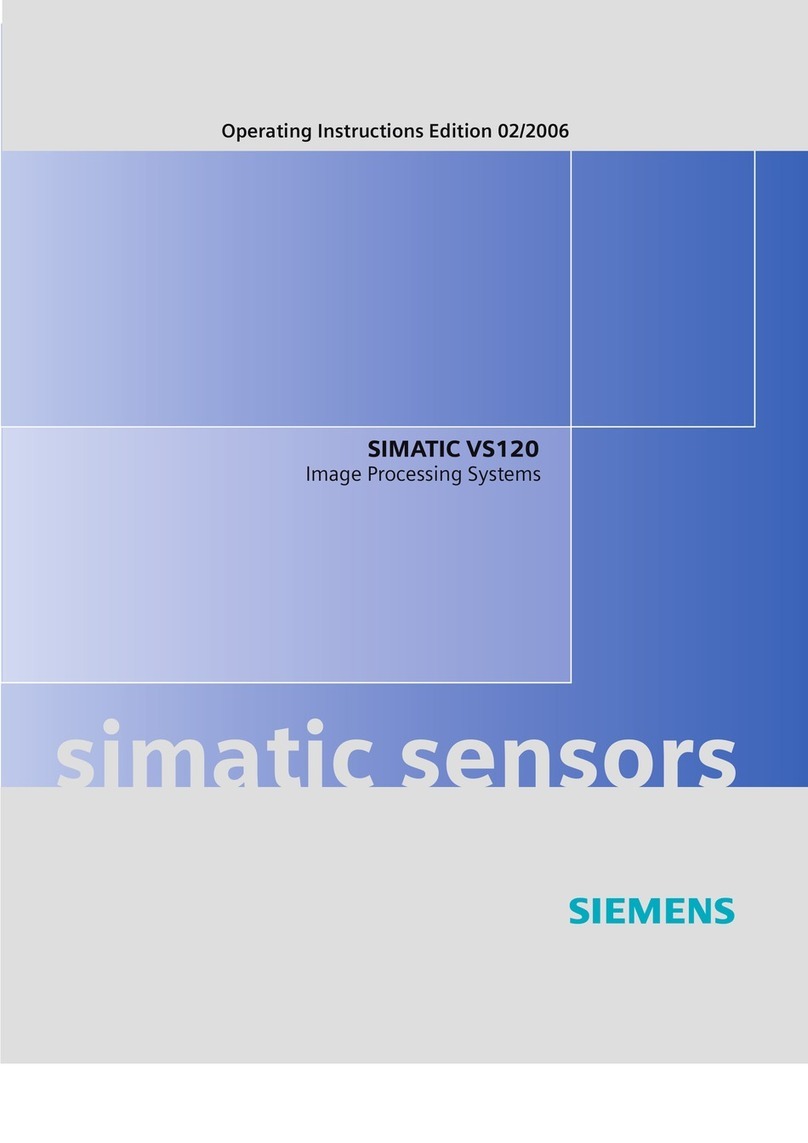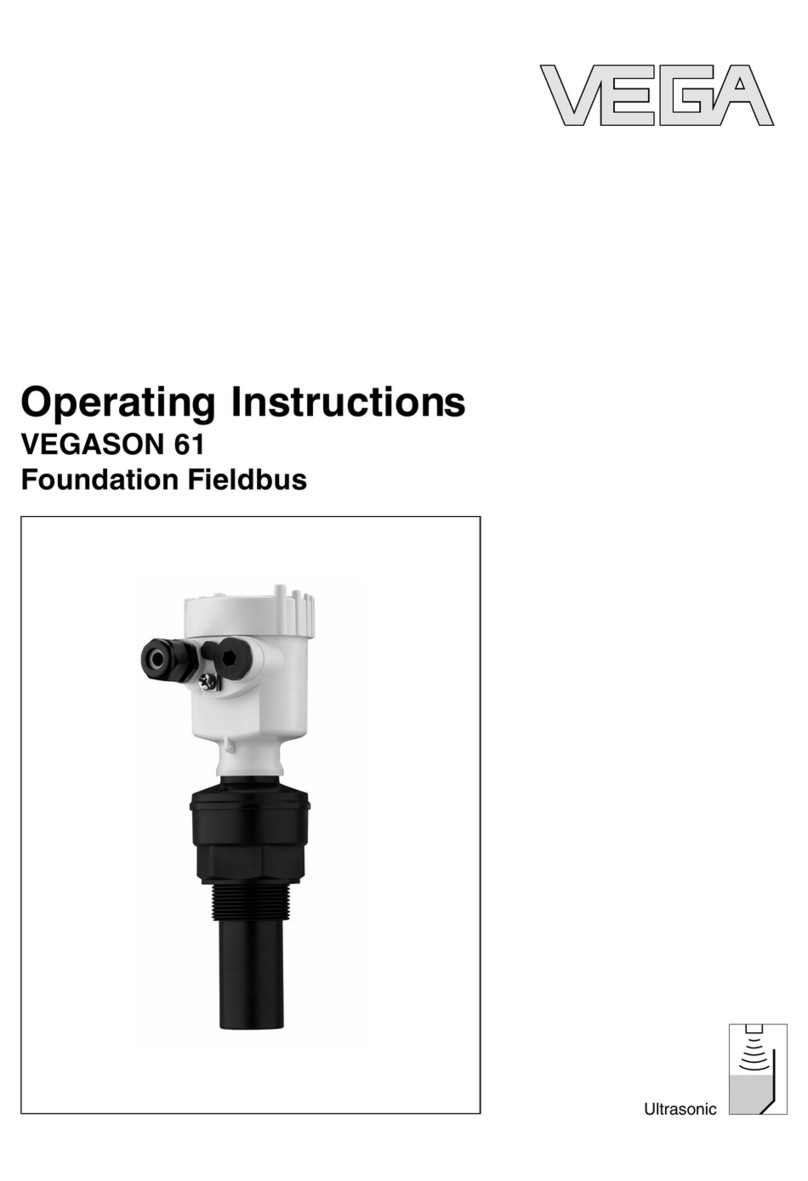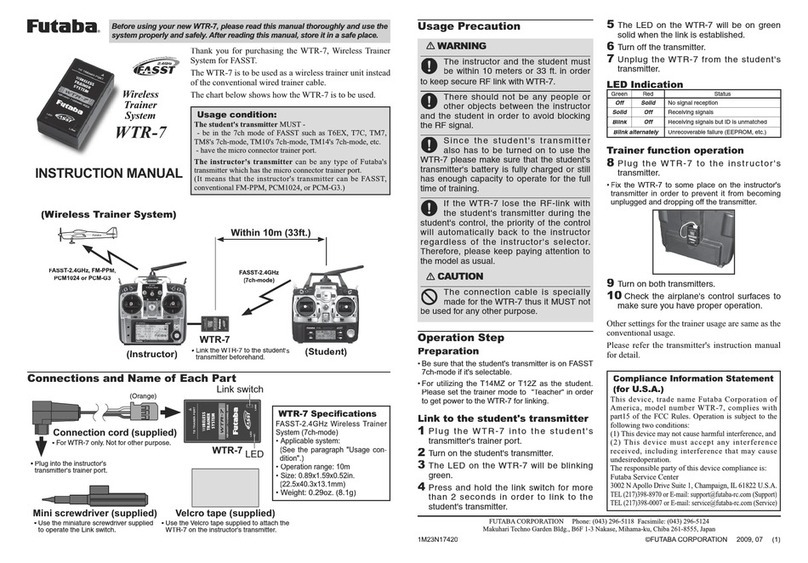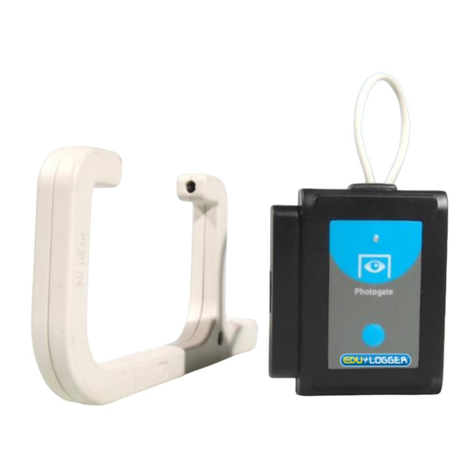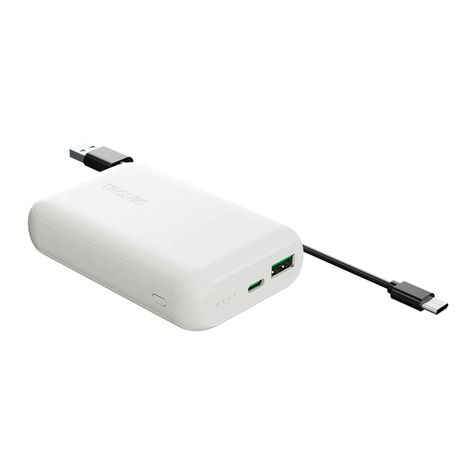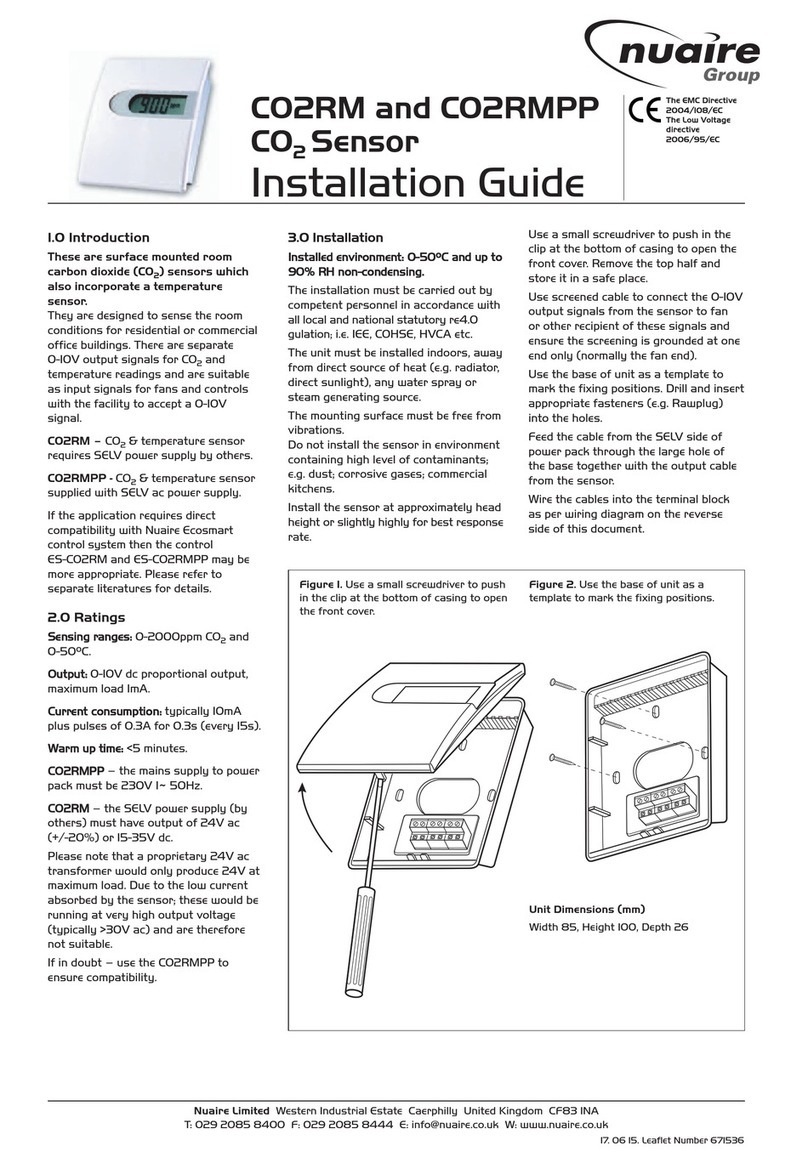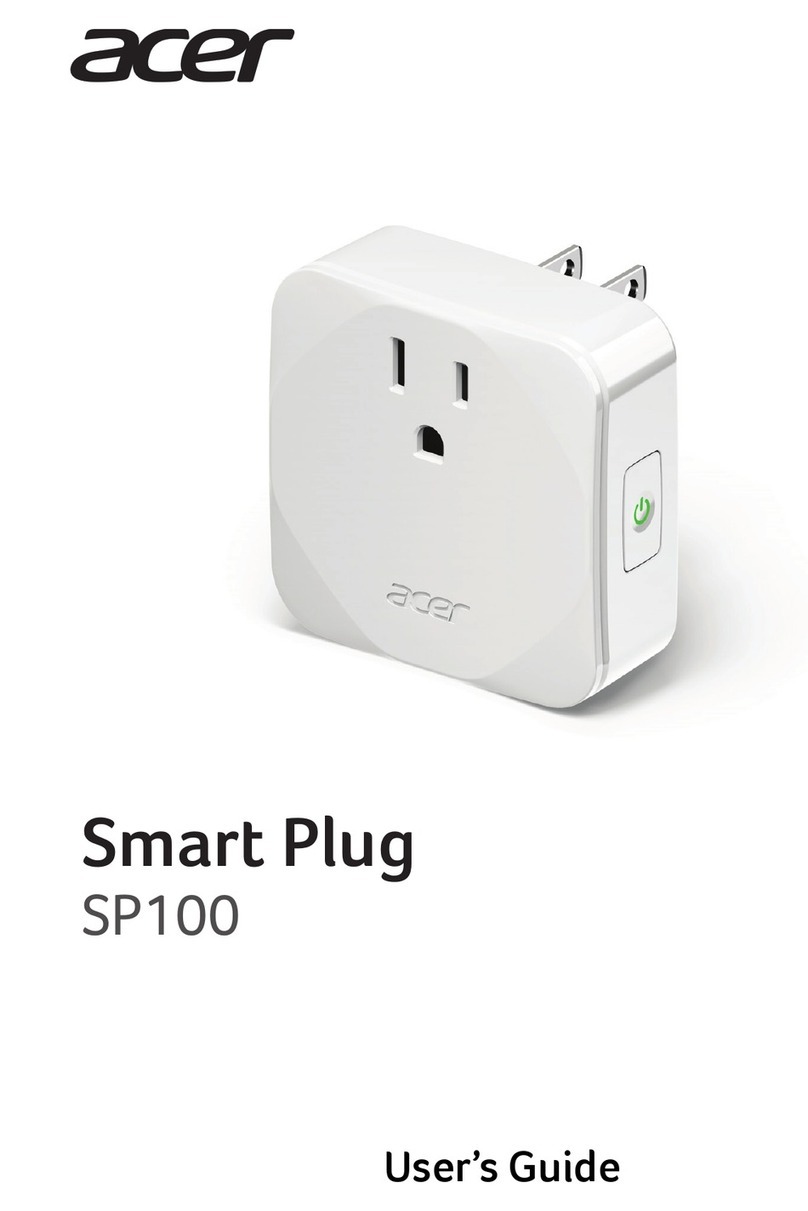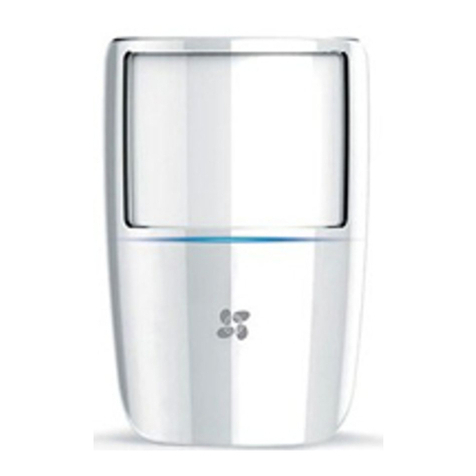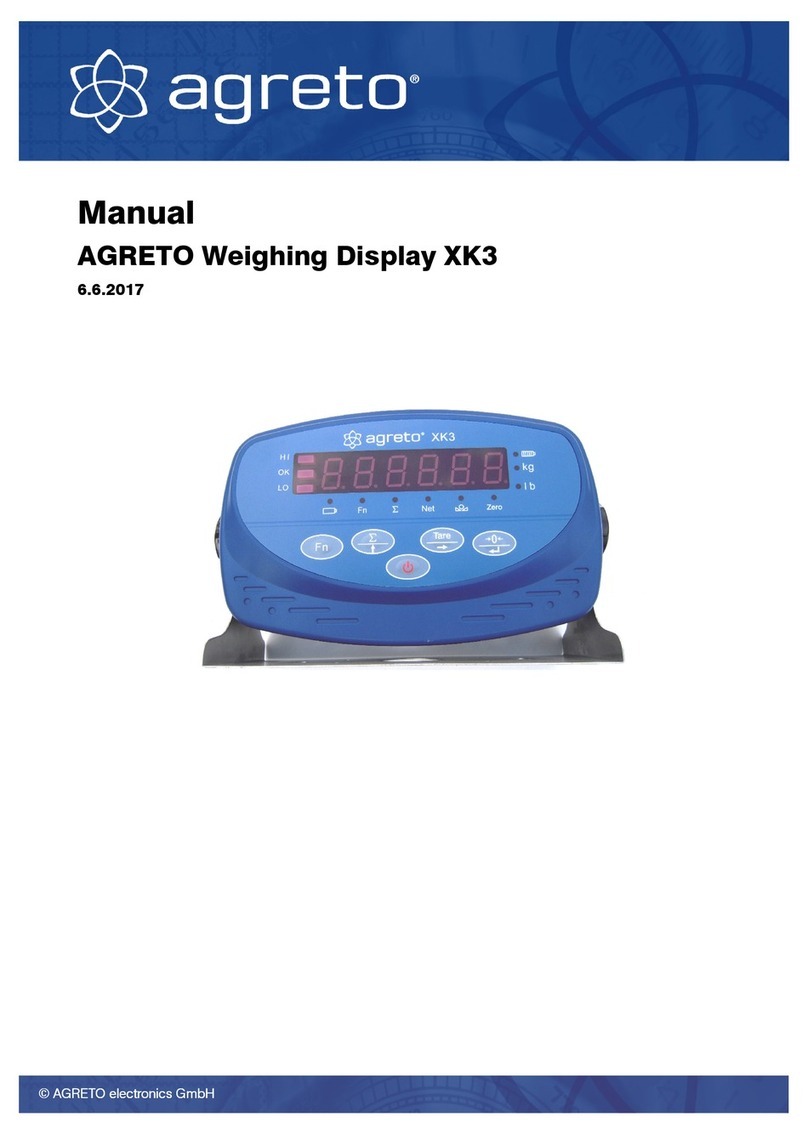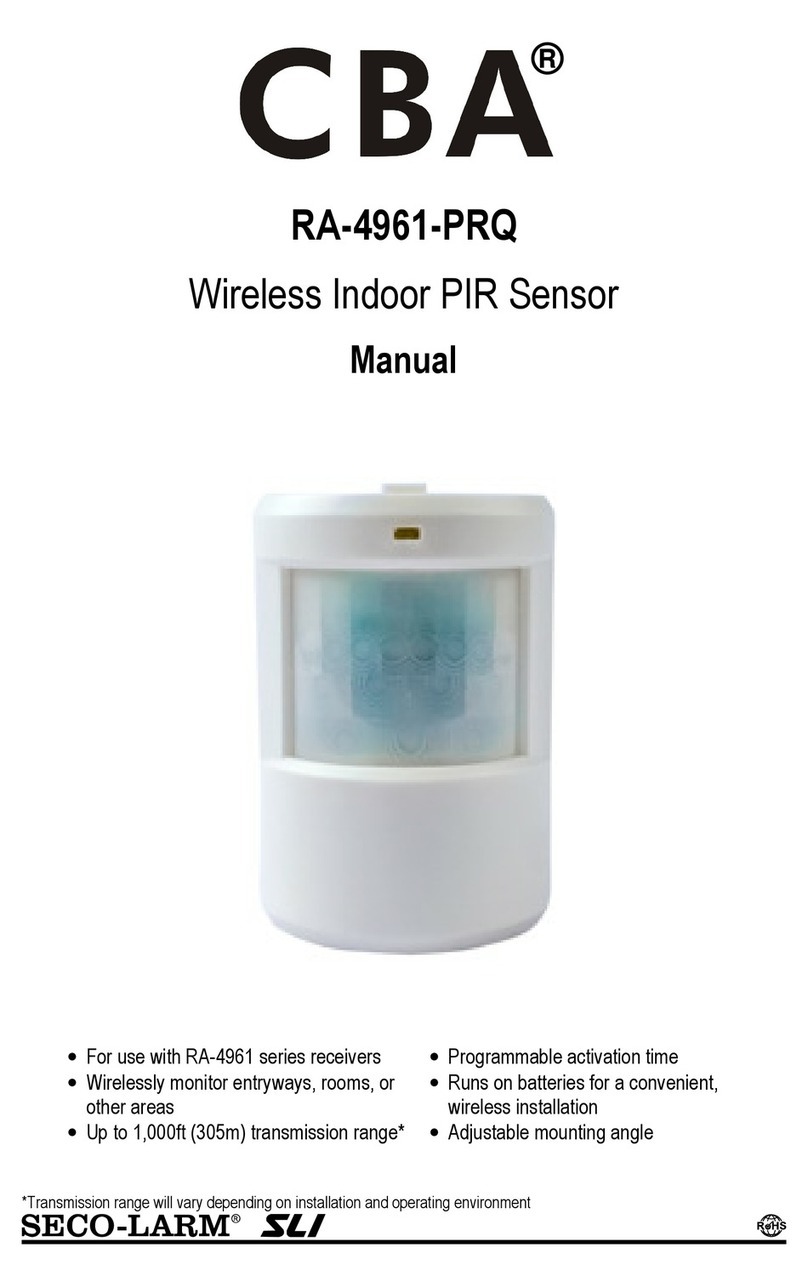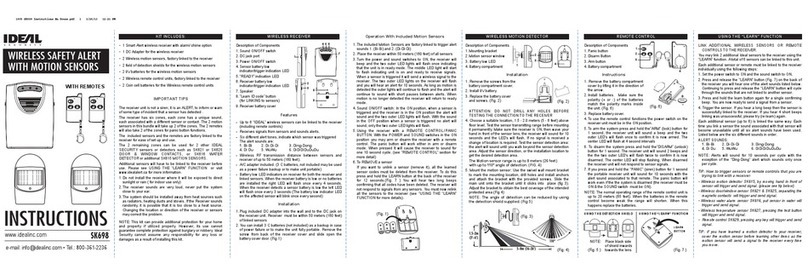Geokon 4900 User manual

©2021, GEOKON. All rights reserved.
Document Revision: BB | Release date: 03/10/21
Model 4900
Vibrating Wire Load Cell
Instruction Manual


WARRANTY STATEMENT
GEOKON warrants its products to be free of defects in materials and workmanship,
under normal use and service for a period of 13 months from date of purchase. If the
unit should malfunction, it must be returned to the factory for evaluation, freight
prepaid. Upon examination by GEOKON, if the unit is found to be defective, it will be
repaired or replaced at no charge. However, the WARRANTY IS VOID if the unit shows
evidence of having been tampered with or shows evidence of being damaged as a
result of excessive corrosion or current, heat, moisture or vibration, improper specifi-
cation, misapplication, misuse or other operating conditions outside of GEOKON's
control. Components that wear or are damaged by misuse are not warranted. This
includes fuses and batteries.
GEOKON manufactures scientific instruments whose misuse is potentially dangerous.
The instruments are intended to be installed and used only by qualified personnel.
There are no warranties except as stated herein. There are no other warranties,
expressed or implied, including but not limited to the implied warranties of merchant-
ability and of fitness for a particular purpose. GEOKON is not responsible for any
damages or losses caused to other equipment, whether direct, indirect, incidental,
special or consequential which the purchaser may experience as a result of the instal-
lation or use of the product. The buyer's sole remedy for any breach of this agreement
by GEOKON or any breach of any warranty by GEOKON shall not exceed the purchase
price paid by the purchaser to GEOKON for the unit or units, or equipment directly
affected by such breach. Under no circumstances will GEOKON reimburse the
claimant for loss incurred in removing and/or reinstalling equipment.
Every precaution for accuracy has been taken in the preparation of manuals and/or
software, however, GEOKON neither assumes responsibility for any omissions or
errors that may appear nor assumes liability for any damages or losses that result
from the use of the products in accordance with the information contained in the
manual or software.
No part of this instruction manual may be reproduced, by any means, without the written consent of GEOKON. The
information contained herein is believed to be accurate and reliable. However, GEOKON assumes no responsibility
for errors, omissions or misinterpretation. The information herein is subject to change without notification.
The GEOKON® wordmark and logo are registered trademarks with the United States Patent and Trademark Office.


I
TABLE OF CONTENTS
1. INTRODUCTION............................................................................................................................................1
1.1 THEORY OF OPERATION...............................................................................................................1
1.2 LOAD CELL DESIGN AND CONSTRUCTION ................................................................2
1.2.1 FRICTION BETWEEN THE BEARING PLATE AND LOAD CELL.......................................3
1.2.2 WARPING OF THE BEARING PLATES AND BEARING PLATE DESIGN ......................4
1.2.3 ECCENTRIC LOADING .....................................................................................................................4
1.2.4 ELASTIC BEHAVIOR .........................................................................................................................5
1.2.5 TEMPERATURE EFFECTS...............................................................................................................5
2. INSTALLATION..............................................................................................................................................6
2.1 PRELIMINARY TESTS......................................................................................................................6
2.2 LOAD CELL INSTALLATION .......................................................................................................6
2.2.1 TRANSPORTATION...........................................................................................................................6
2.2.2 INITIAL NO-LOAD READING.........................................................................................................6
2.2.3 INSTALLATION ON TIE-BACKS AND ROCKBOLTS .............................................................6
2.3 CABLE INSTALLATION AND SPLICING ..........................................................................6
2.4 ELECTRICAL NOISE ...........................................................................................................................7
2.5 ENVIRONMENTAL FACTORS ....................................................................................................7
2.6 LIGHTNING PROTECTION............................................................................................................7
3. TAKING READINGS .................................................................................................................................9
3.1 GK-404 VIBRATING WIRE READOUT................................................................................9
3.1.1 OPERATING THE GK-404 ...............................................................................................................9
3.2 GK-405 VIBRATING WIRE READOUT............................................................................ 10
3.2.1 CONNECTING SENSORS WITH 10-PIN BULKHEAD CONNECTORS
ATTACHED ....................................................................................................................................... 10
3.2.2 CONNECTING SENSORS WITH BARE LEADS................................................................... 10
3.2.3 OPERATING THE GK-405 ........................................................................................................... 10
3.2.4 READOUT IN LOAD UNITS........................................................................................................ 11
3.3 MEASURING TEMPERATURES ........................................................................................... 12
4. DATA REDUCTION ................................................................................................................................13
4.1 LOAD CALCULATION ................................................................................................................... 13
4.2 TEMPERATURE CORRECTION FACTOR ...................................................................... 14
5. TROUBLESHOOTING .......................................................................................................................... 16
APPENDIX A. SPECIFICATIONS .................................................................................................. 17
A.1 MODEL 4900 LOAD CELL SPECIFICATIONS.......................................................... 17
A.2 THERMISTOR...................................................................................................................................... 17

II
APPENDIX B. THERMISTOR TEMPERATURE DERIVATION ....................... 18
APPENDIX C. WIRING AND CONNECTOR PINOUTS.......................................... 19
C.1 LOAD CELL CONNECTOR AND CABLE (STANDARD WIRING)............... 19
C.2 GK-403 TO MODULE CONNECTOR ................................................................................. 19
APPENDIX D. LOAD CELL GAUGE FACTOR RECALCULATION............... 20
D.1 OVERVIEW ............................................................................................................................................. 20
D.2 PROCEDURE......................................................................................................................................... 20
APPENDIX E. LOAD CELL CALIBRATIONS - EFFECTS OF
BEARING PLATE WARPING...................................................................... 21
E.1 INTRODUCTION................................................................................................................................. 21
E.2 LOAD CELL CALIBRATION PROCEDURES................................................................. 21
E.3 FIELD ARRANGEMENT................................................................................................................ 21
E.4 EFFECTS OF JACK SIZE ON LOAD CELL READING .......................................... 21
E.5 CONCLUSION....................................................................................................................................... 22
APPENDIX F. USE OF THE REGRESSION ZERO WHEN USING
THE LINEAR GAUGE FACTOR................................................................. 23
APPENDIX G. MODEL 8032-27 AND LOAD CELL WIRING.......................... 24

III
FIGURES
FIGURE 1: LOAD CELLS ON TIEBACKS FOR MONITORING ...........................................1
FIGURE 2: LOAD CELLS ON TIEBACKS FOR TESTING ....................................................2
FIGURE 3: LOAD CELLS FOR LOAD MONITORING DURING PILE LOAD TEST .............2
FIGURE 4: MODEL 4900 LOAD CELL SIDE VIEW ...........................................................3
FIGURE 5: TYPICAL LOAD CELL SYSTEM ........................................................................3
FIGURE 6: GK-404 READOUT ...........................................................................................9
FIGURE 7: LEMO CONNECTOR TO GK-404 .....................................................................9
FIGURE 8: GK-405 READOUT .........................................................................................10
FIGURE 9: TYPICAL MODEL 4900 CALIBRATION SHEET .............................................15
FIGURE 10: MODEL 8032-27 JUMPER WIRE ASSEMBLY ...........................................24

IV
TABLES
TABLE 1: ENGINEERING UNITS CONVERSION MULTIPLIERS....................................13
TABLE 2: MODEL 4900 LOAD CELL SPECIFICATIONS.................................................17
TABLE 3: 3KΩ THERMISTOR RESISTANCE....................................................................18
TABLE 4: STANDARD LOAD CELL WIRING ...................................................................19
TABLE 5: MODULE WIRING.............................................................................................19
TABLE 6: GAUGE FACTOR FOR REMAINING GAUGES................................................20
TABLE 7: EFFECTS OF JACK SIZING ON READINGS ...................................................22

V
EQUATIONS
EQUATION 1: DIGITS CALCULATION .............................................................................. 13
EQUATION 2: LOAD CALCULATION USING LINEAR REGRESSION............................. 13
EQUATION 3: LOAD CALCULATION USING POLYNOMIAL .......................................... 14
EQUATION 4: LOAD, CORRECTED FOR TEMPERATURE .............................................. 14
EQUATION 5: 3KΩ THERMISTOR RESISTANCE............................................................. 18

VI

MODEL 4900 VIBRATING WIRE LOAD CELL | INTRODUCTION | 1
1. INTRODUCTION
1.1 THEORY OF OPERATION
GEOKON load cells are of an annular design primarily for use on tiebacks and
rockbolts. They may also be used during pile load tests and for monitoring loads
in cross-lot struts and tunnel supports, etc. In practically all cases, the load cells
are used in conjunction with a hydraulic jack, which applies the load, and with
bearing plates positioned on either side of the load cell.
GEOKON Model 4900 load cells are frequently used for the following:
■To provide a permanent means of monitoring the load throughout the life of
the tieback, rockbolt, strut or support, etc.
■To provide an electronic output for automatic data gathering.
■As a check on the load as determined by the hydraulic pressure applied to
the jack during proof testing on tiebacks, rockbolts, etc. For this purpose,
the user should be aware that the agreement cannot be guaranteed
better than ±20% because of the many variables.
Load cells are positioned so that the tensile load in the tieback or rockbolt
produces a compressive load in the load cell. This is done by trapping the load
cell between bearing plates positioned between the jack and the structure,
either below the anchor plate for permanent installations or above the anchor
plate for proof testing. Figure 1 and Figure 2 show the two different installations.
1:
FIGURE 1: Load Cells on Tiebacks for the Permanent Monitoring of Loads
Tendon or Rod
Bearing Plates
Lock Off Nut
Load Cell
Wale
Soldier Pile
Anchor Zone

2| INTRODUCTION | GEOKON
2:
FIGURE 2: Load Cells on Tiebacks For Proof Testing Only
Figure 3 illustrates load cells being used for load monitoring during a pile load test.
3:
FIGURE 3: Load Cells for Load Monitoring During Pile Load Test
1.2 LOAD CELL DESIGN AND CONSTRUCTION
The Model 4900 Load Cell body is constructed in the form of a high strength
steel cylinder in which three to six vibrating wire strain gauges are embedded to
measure the change of strain in the cylinder as it comes under load. Multiple
gauges are needed to account for the effects of off-center or eccentric loading.
The cable is attached to the cell through a waterproof gland. A Kellem's grip
strain relief prevents the cable from being pulled out of the cell. Cables have
thick PVC jackets and can be terminated in a connector to mate with terminal
boxes or readouts. See Appendix C for cable and connector diagrams. Figure 4
below shows a typical load cell.
Anchor Zone
Tendon or Rod
Bearing Plates
Loading Shoe
Hydraulic
Jack
Load Cell
Lock Off Nut
Soldier Pile
Wale
Load Cell #1 Load Cell #2
Spherical Bearing Spherical Bearing
Hydraulic Jacks
Reaction Beam
Threaded Bars (6) Threaded Bars (6)
Ground Surface Load Plate
Test Pile Reaction Pile #2
Reaction Pile #1

MODEL 4900 VIBRATING WIRE LOAD CELL | INTRODUCTION | 3
4:
FIGURE 4: Model 4900 (Three Gauge) Load Cell
Additional cable protection can be obtained by either using armored cable or by
placing the cable inside flex conduit. Figure 5 shows a typical load cell system.
5:
FIGURE 5: Typical Load Cell System
Annular load cells, because of their design, are inherently susceptible to varying
conditions of end loading, unlike solid load cells, which can be designed with
button shaped ends so that the load always falls in a uniform, predictable
fashion. Thus, the output and calibration of an annular load cell can be affected
by the factors discussed in the subsections below. Note that all of these effects
can be accumulative, and can cause the calibration to vary by as much as
20%, unless special precautions are taken.
1.2.1 FRICTION BETWEEN THE BEARING PLATE AND LOAD CELL
Friction between the bearing plate and the load cell can radically affect the
performance of a load cell. Interposing deformable plates or lubricant between
the bearing plates and the load cell in the field will cause the load cell to over-
register, perhaps by as much as 10%. Again, for best results, it is important
to calibrate the load cell in the laboratory under the same loading
conditions as will be used in the field.
End effects of this nature can be reduced somewhat by using tall load cells. A
rough rule of thumb for good load cell design calls for a load cell height at least
four times the wall thickness of the loaded annulus. On some jobs where there
Cover Screws
Cover
Instrument Cable
Kellums
Grip
Outer Diameter
OD
ID
Inner Diameter
Side View Top View
Enclosure
Cover Clasp
Load Cell
Load Cell
Flex Conduit
Conduit
Connector
Instrument Cable
Conduit Connector

4| INTRODUCTION | GEOKON
are space restrictions calling for a pancake style load cell, friction between
bearing plates and load cell can give rise to large hysteresis effects between
loading and unloading cycles.
1.2.2 WARPING OF THE BEARING PLATES AND BEARING PLATE DESIGN
Warping of the bearing plates is caused primarily by a size mismatch between
the hydraulic jack and the load cell. A jack larger than the load cell tends to wrap
the intervening bearing plate around the load cell, causing the center of the load
cell to "hourglass" or pinch inwards causing the load cell to under-register.
Conversely, a hydraulic jack smaller than the load cell will try to punch the
intervening bearing plate through the center of the load cell, making the center
of the load cell barrel outwards causing the load cell to over-register.
Both effects are exacerbated by bearing plates that are too thin. For further
details on this topic, see Appendix D.
Note: To protect the lead wires routed in a groove in one face of the load cell
GEOKON does not allow the use of a washer made from lead, copper, rubber or
other soft material bearing against this surface. If a soft washer is used be sure it
is used only on the other face, i.e., the one that does not have the annular epoxy-
filled groove.
Minimum bearing plate thickness is 25 mm (1") where load cell size matches
hydraulic jack size, i.e., the load bearing annulus of the load cell falls within the
load bearing annulus of the hydraulic jack. For any other condition of size
mismatch, the bearing plates should be at least two inches thick and even
thicker where the size mismatch is extreme or the loads large.
Bearing plates should be flat and smooth. The normal rolled steel plate surface is
adequate. It is not necessary to have machined or ground surfaces. Where
plates are cut from larger plates, using cutting torches, the edges should be
carefully cleaned to remove welding slag and solidified molten lumps.
Consideration should be given to calibrating the load cell using the same bearing
plates as will be used in the field. In addition, it is possible to simulate the size of
the hydraulic jack using a suitably sized metal donut between the upper platen
of the testing machine and the upper bearing plate. Load cells calibrated in this
way will be much more likely to agree with the hydraulic jack in the field.
1.2.3 ECCENTRIC LOADING
Eccentric loading of load cells is the rule rather than the exception. Rarely is the
axis of the tieback, rockbolt, or strut at right angles to the surface on which the
anchor plate or strut rests. With tiebacks using multiple tendons, it is quite
common for loads in individual tendons to vary markedly, despite best efforts to
avoid this happening. In addition, struts are rarely at right angles to the soldier
piles they may be supporting.
These factors combine to produce conditions in which the load cell experiences
loads that are higher on one side than on the other. This effect is compensated
for by the individual electrical resistance strain gauges, cemented to the cell,
being connected together in a full Wheatstone Bridge circuit. Thus, the higher
strains on one side are balanced by lower strains on the other and the average
strain is not affected. Thus, even gross amounts of load eccentricity cause only
slight (< 5%) variations in the load cell output and calibration.
Eccentric loading can be minimized by using spherical bearing plates, but this is
expensive and is rarely done. Spherical seats may be of some value during pile
load testing where uniformity of the load on the top of the pile is highly
desirable.

MODEL 4900 VIBRATING WIRE LOAD CELL | INTRODUCTION | 5
1.2.4 ELASTIC BEHAVIOR
It is important that a load cell behave elastically, i.e. that the no-load zero will not
change with time. For this reason, use only the highest quality strain gauges and
adhesives. GEOKON uses transducer-grade strain gauges, along with scrupulous
observation of the best installation practices and adhesive post curing
techniques.
GEOKON Model 4900 Load Cells are designed to keep the normal working
stresses below 30% of the yield stress of the load cell material. Wherever
possible load cells are cycled to 150% of the design load prior to calibration. As
long as the load cell is never overloaded above this range, the no-load reading
will not change. The normal over-range capacity of an aluminum load cell is
200% FSR and 300−400% FSR for a steel load cell before the load cell will begin
to fail.
If a load cell is over-ranged and the no-load reading is shifted due to plastic
yielding of the cell, then the cell should be returned to the factory for inspection
and recalibration. Note, however, that while the no-load zero may shift, the
calibration constant will probably not be affected.
1.2.5 TEMPERATURE EFFECTS
Temperature compensation is achieved by using strain gauges whose thermal
coefficient is the same as that of the load cell material. Normally, the
temperature coefficient of the load cell is insignificant. In special cases, if
required, the coefficient can be measured at the factory. Note that temperature
changes on the loaded rockbolt, tieback, or strut can produce real changes of
load and these will be recorded by the load cell. See Section 4.2 for more
information on correcting for temperature.

6| INSTALLATION | GEOKON
2. INSTALLATION
2.1 PRELIMINARY TESTS
Before installing the load cell, it should be checked by connecting it to the
readout box and taking a no-load reading. This reading, when compared with
that given in the calibration data provided with the load cell, will show if the cell
is functioning properly. The two readings should agree within about 50 digits
(assuming that the same readout box is used for both readings).
2.2 LOAD CELL INSTALLATION
2.2.1 TRANSPORTATION
When transporting load cells, do not pull on the cable and, in particular, do not
carry the load cell by the cable. On the larger load cells, threaded holes are
provided in the ends to allow eyebolts to be attached for lifting purposes.
2.2.2 INITIAL NO-LOAD READING
Before installing the load cell, be sure to take the no-load reading. This
reading is very important, since it will be subtracted from all subsequent
readings to calculate the load. Note that each load cell has a different no-load
reading that is not zero. See Section 3 for operation of the readout boxes.
2.2.3 INSTALLATION ON TIE-BACKS AND ROCKBOLTS
Note: To protect the lead wires routed in a groove in one face of the load cell
GEOKON does not allow the use of a washer made from lead, copper, rubber or
other soft material bearing against this surface. If a soft washer is used, be sure
it is used only on the other face, i.e., the one that does not have the annular
epoxy-filled groove
Load cells should be installed between flat steel bearing plates of sufficient
thickness; one inch thick where load cell and jack are about the same size, and
two to three inches thick where size mismatches are greater. The normal rolled
finish on the plates is good. Plates may need to be machined flat if they are
warped. Make sure that the bearing plates completely cover the load-bearing
surface of the load cell. Centralize the rockbolt or tieback inside the load cell.
Where the load cell I.D. is much bigger than the rockbolt or tieback, a centralizer
bushing can be used.
Where the anchor block of a multi-tendon tieback bears directly on the load cell,
make sure that the load cell bearing surface is completely covered by the anchor
block. If the load cell is not completely covered, then make sure that the
calibration was performed using the anchor block. If the calibration was
performed without the anchor block then for best results consideration should
be given to recalibration with the anchor block.
Shield the cable for possible damage from blasting or traffic. Protect the end of
the cable or the cable connector from dirt by either using a cap on the connector
or by storing the end of the cable and/or connector inside a small box. Section 1
shows a typical load cell system.
2.3 CABLE INSTALLATION AND SPLICING
The cable should be routed to minimize the possibility of damage due to moving
equipment, debris or other causes. The cable can be protected by the use of
flexible conduit, which can be supplied by GEOKON.
Terminal boxes with sealed cable entries are available from GEOKON for all types
of applications. These allow many gauges to be terminated at one location with

MODEL 4900 VIBRATING WIRE LOAD CELL | INSTALLATION | 7
complete protection of the lead wires. The interior panel of the terminal box can
have built-in jacks or a single connection with a rotary position selector switch.
Contact GEOKON for specific application information.
Because the vibrating wire output signal is a frequency rather than a current or
voltage, variations in cable resistance have little effect on gauge readings;
therefore, splicing of cables has no ill effects, and in some cases may in fact be
beneficial. The cable used for making splices should be a high quality twisted
pair type, with 100% shielding and an integral shield drain wire. When splicing,
it is very important that the shield drain wires be spliced together.
Always maintain polarity by connecting color to color.
Splice kits recommended by GEOKON employ casts, which are placed around
the splice and are then filled with epoxy to waterproof the connections. When
properly made, this type of splice is equal or superior to the cable in strength
and electrical properties. Contact GEOKON for splicing materials and additional
cable splicing instructions.
Cables may be terminated by stripping and tinning the individual conductors and
then connecting them to the patch cord of a readout box. Alternatively, a
connector may be used which will plug directly into the readout box or into a
receptacle on a special patch cord.
2.4 ELECTRICAL NOISE
Care should be exercised when installing instrument cables to keep them as far
away as possible from sources of electrical interference such as power lines,
generators, motors, transformers, arc welders, etc. Cables should never be
buried or run alongside AC power lines; they will pick up the noise from the
power cable, which will likely cause unstable readings. Contact the factory
concerning filtering options available for use with the GEOKON dataloggers and
readouts.
2.5 ENVIRONMENTAL FACTORS
Since the purpose of the load cell installation is to monitor site conditions,
factors which may affect these conditions should be observed and recorded.
Seemingly minor effects may have a real influence on the behavior of the
structure being monitored and may give an early indication of potential
problems. Some of these factors include, but are not limited to: blasting, rainfall,
tidal or reservoir levels, excavation and fill levels and sequences, traffic,
temperature and barometric changes, changes in personnel, nearby
construction activities, seasonal changes, etc.
2.6 LIGHTNING PROTECTION
Unlike other types of instrumentation available from GEOKON, load cells do not
have any integral lightning protection components, such as transorbs or plasma
surge arrestors. Usually this is not a problem, however, if the instrument cable is
exposed, it may be appropriate to install lightning protection components, as the
transient could travel down the cable to the gauge and possibly destroy it.
Recommended lightning protection is as follows:
■If the instrument is connected to a terminal box or multiplexer, components
such as plasma surge arrestors (spark gaps) may be installed in the terminal
box/multiplexer to provide a measure of transient protection. Terminal
boxes and multiplexers available from GEOKON provide locations for the
installation of these components.

8| INSTALLATION | GEOKON
■Lighting arrestor boards and enclosures are also available from GEOKON.
These units install where the instrument cable exits the structure being
monitored. The enclosure has a removable top to allow the customer to
service the components or replace the board in the event that the unit is
damaged by a lightning strike. A connection is made between the enclosure
and earth ground to facilitate the passing of transients away from the load
cell.
■Plasma surge arrestors can be epoxied into the instrument cable, close to
the load cell. A ground strap then connects the surge arrestor to an earth
ground, such as a grounding stake.
Consult the factory for additional information on available lightning protection.

MODEL 4900 SERIES VIBRATING WIRE LOAD CELL | TAKING READINGS | 9
3. TAKING READINGS
3.1 GK-404 VIBRATING WIRE READOUT
The Model GK-404 VW Readout is a portable, low-power, hand-held unit that is
capable of running for more than 20 hours continuously on two AA batteries. It
is designed for the readout of all GEOKON vibrating wire instruments, and is
capable of displaying the reading in digits, frequency (Hz), period (µs), or
microstrain (µε). The GK-404 also displays the temperature of the transducer
(embedded thermistor) with a resolution of 0.1 °C.
6:
FIGURE 6: GK-404 Readout
3.1.1 OPERATING THE GK-404
1. Attach the flying leads by aligning the red circle on the silver Lemo
connector with the red line on the top of the GK-404 (see Figure 7). Insert
the Lemo connector into the GK-404 until it locks into place.
2. Connect each of the clips on the leads to the matching colors of the sensor
conductors, with blue representing the shield (bare).
3. To turn on the GK-404, press the On/Off button on the front panel of the
unit. The initial startup screen will display.
4. After a delay, the GK-404 will start taking readings and display them based
on the settings of the Pos and Mode buttons.
The unit display (from left to right) is as follows:
■The current position: set by the Pos button, displayed as A through F.
■The current reading: set by the Mode button, displayed as a numeric value
followed by the unit of measure.
■Temperature reading of the attached instrument in degrees Celsius.
Use the Pos and Mode buttons to select the correct position and display units
for the model of equipment purchased.
The GK-404 will continue to take measurements and display readings until the
unit is turned off, either manually or by the Auto-Off timer (if enabled).
For more information, consult the GK-404 manual.
7:
FIGURE 7: Lemo Connector to GK-404

10 | TAKING READINGS | GEOKON
3.2 GK-405 VIBRATING WIRE READOUT
The GK-405 Readout is made up of two components:
■The Readout Unit, consisting of a Windows Mobile handheld PC running
the GK-405 Vibrating Wire Readout application.
■The GK-405 Remote Module, which is housed in a weather-proof enclosure.
The remote module can be wire-connected to the sensor by means of:
■Flying leads with alligator clips if the sensor cable terminates in bare wires.
■A 10-pin connector.
The two units communicate wirelessly using Bluetooth®, a reliable digital
communications protocol. Using Bluetooth, the unit can operate from the cradle
of the remote module, or, if more convenient, can be removed and operated up
to 20 meters away from the remote module.
The GK-405 displays the thermistor temperature in degrees Celsius.
For further details, consult the GK-405 Instruction Manual.
FIGURE 8: GK-405 Readout 3.2.1 CONNECTING SENSORS WITH 10-PIN BULKHEAD CONNECTORS
ATTACHED
Align the grooves on the sensor connector (male), with the appropriate
connector on the readout (female connector, labeled senor or load cell). Push
the connector into place, and then twist the outer ring of the male connector
until it locks into place.
3.2.2 CONNECTING SENSORS WITH BARE LEADS
Attach the flying leads to the bare leads of a GEOKON vibrating wire sensor by
connecting each of the clips on the leads to the matching colors of the sensor
conductors, with blue representing the shield (bare).
3.2.3 OPERATING THE GK-405
Press the power button on the Readout Unit. After start-up completes, a blue
light will begin flashing, signifying that the two components are ready to
connect wirelessly. Launch the GK-405 VWRA program by doing the following:
1. Tap Start on the hand-held PC's main window.
2. Select Programs.
3. Tap the GK-405 VWRA icon.
After a few seconds, the blue light should stop flashing and remain lit. The Live
Readings window will display on the hand-held PC.
Set the Display mode to B.
■For load cells connected with a 10-pin bulkhead connector, choose Sensor
Index "AVG". The average digit reading of all strain gauges in the load cell
will be displayed.
■For load cells connected with flying leads, choose Sensor Index "1". The
digit reading of the currently connected strain gauge will be displayed.
If no reading displays or the reading is unstable, see Section 5 for
troubleshooting suggestions.
For more information, consult the GK-405 Instruction Manual.
Table of contents
Other Geokon Accessories manuals
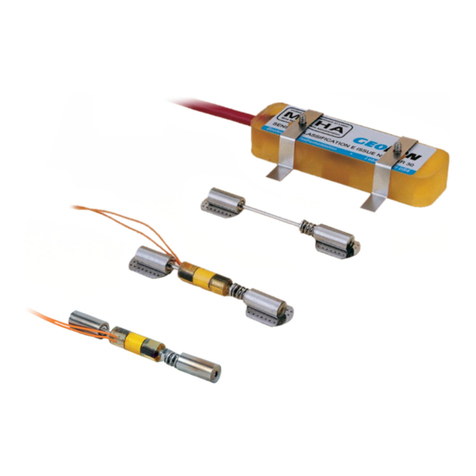
Geokon
Geokon 4100 Series User manual

Geokon
Geokon RB-500 User manual
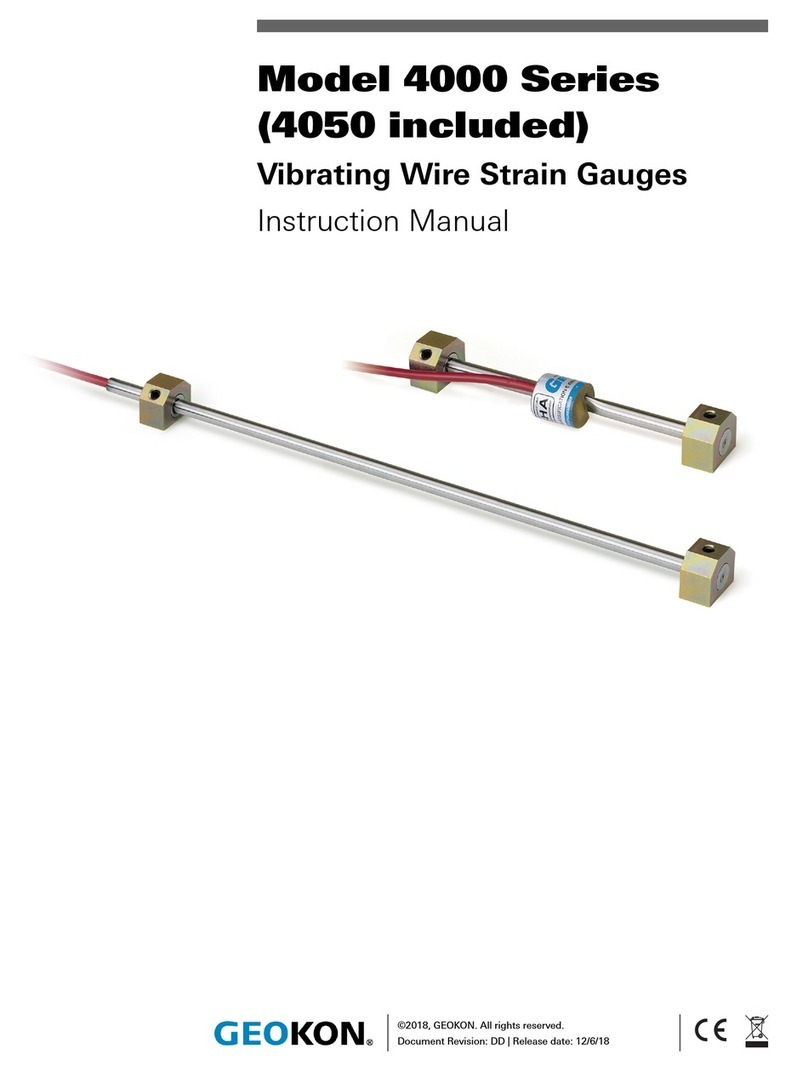
Geokon
Geokon 4000 Series User manual
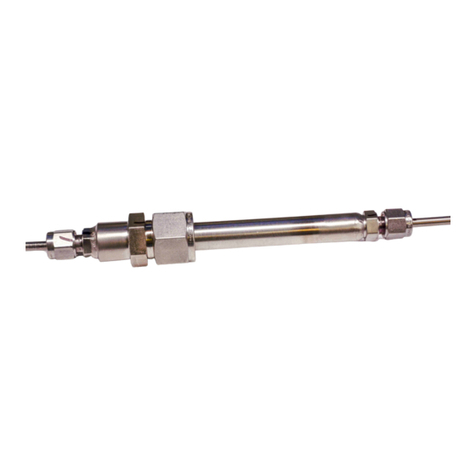
Geokon
Geokon 4500HT-9-5 Manual
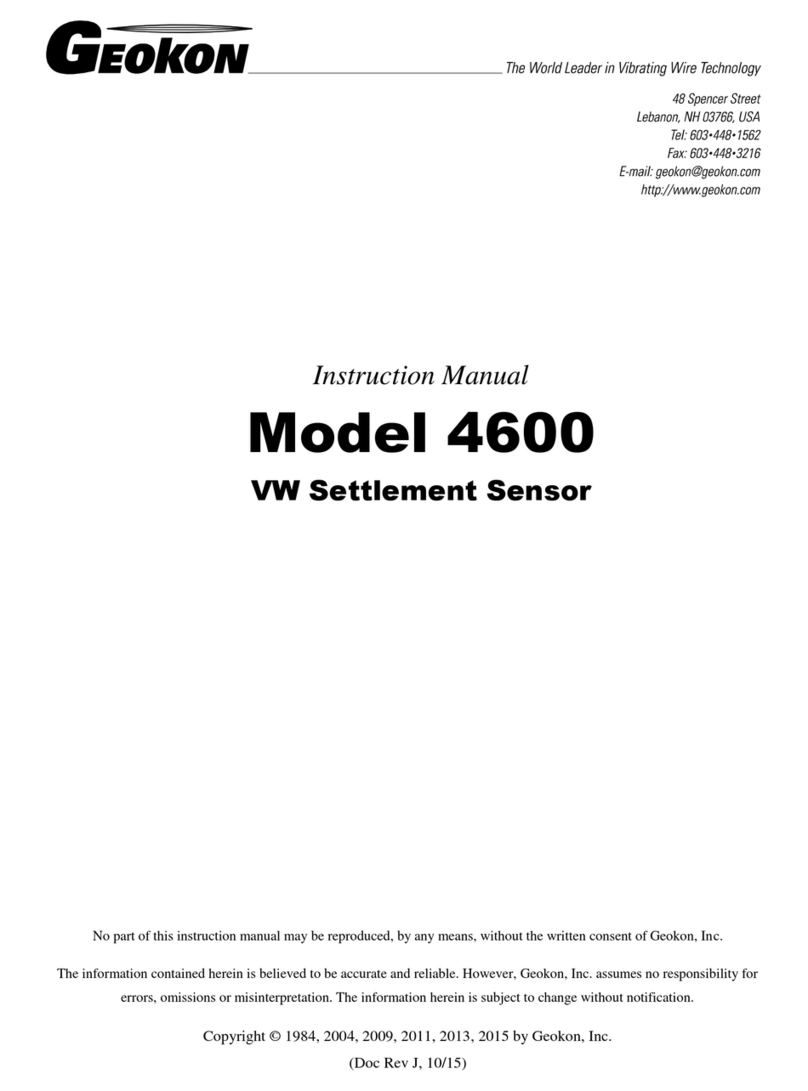
Geokon
Geokon 4600 User manual
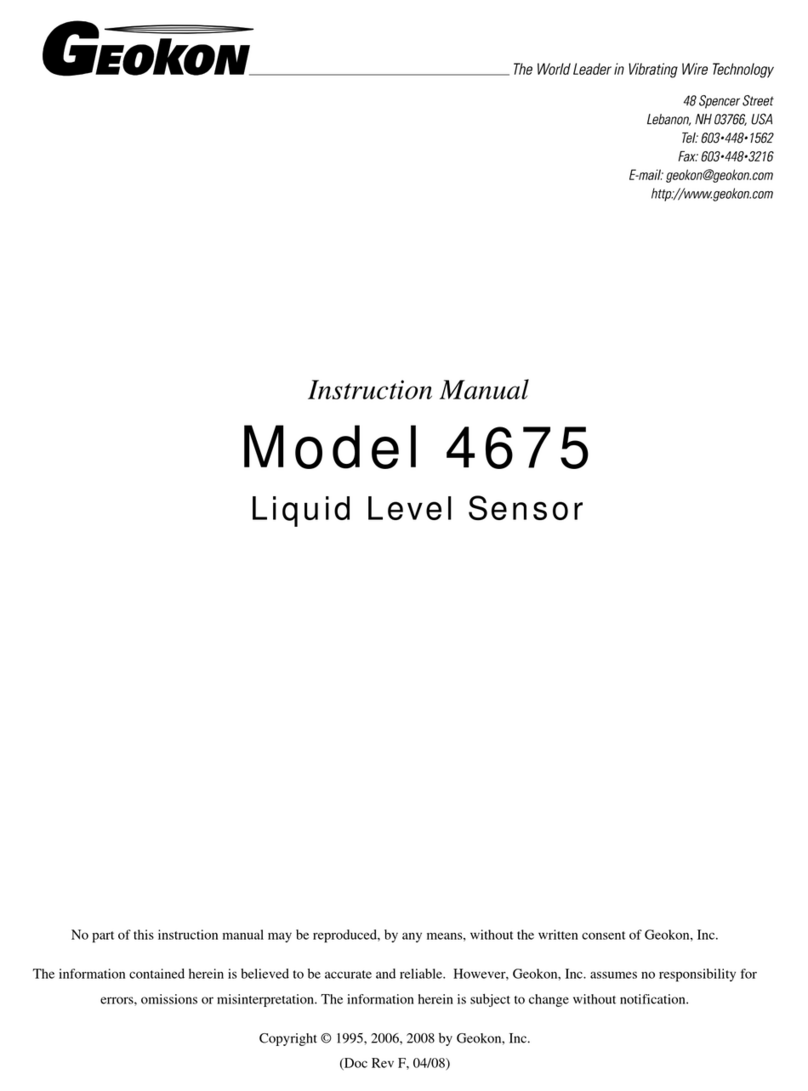
Geokon
Geokon LVRA1230B User manual

Geokon
Geokon 6160 User manual
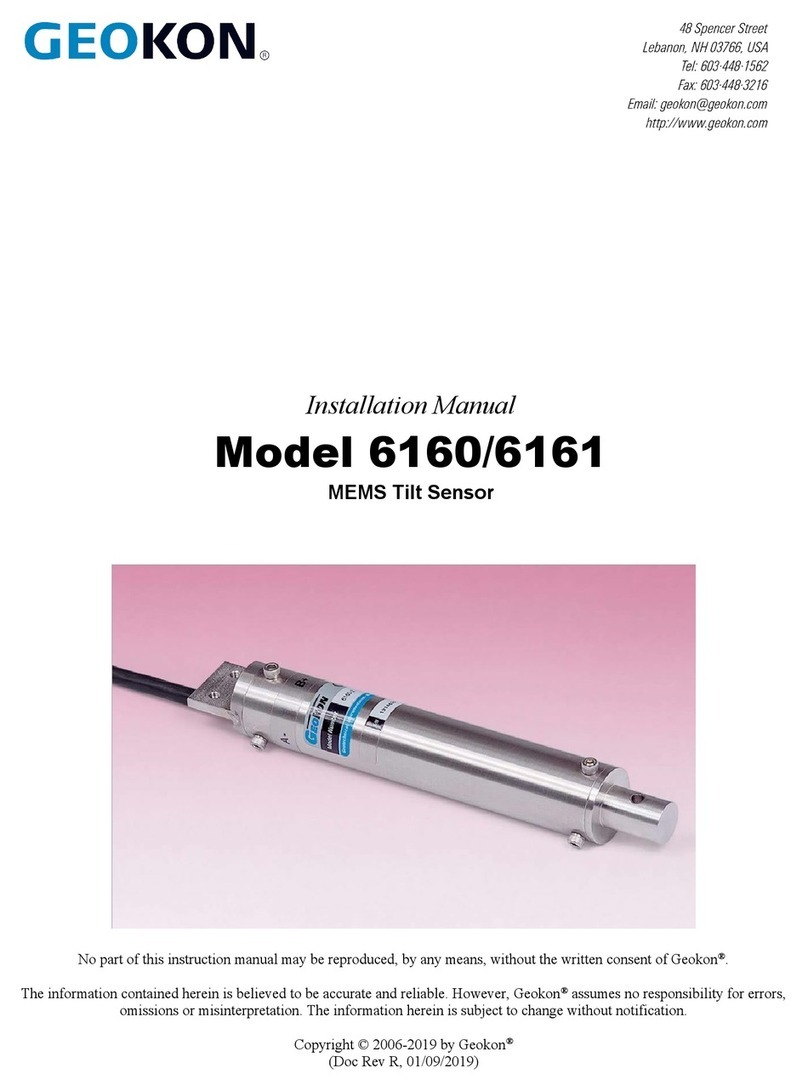
Geokon
Geokon 6160 User manual

Geokon
Geokon 6160 User manual
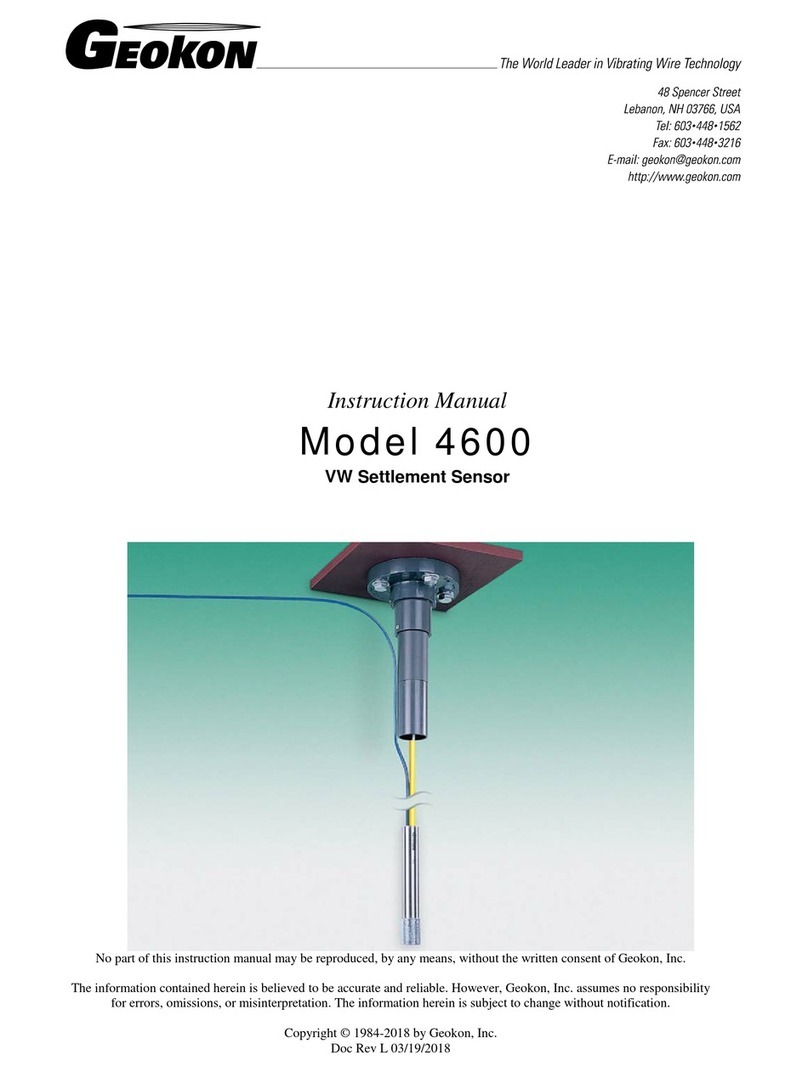
Geokon
Geokon 4600 User manual
